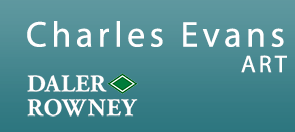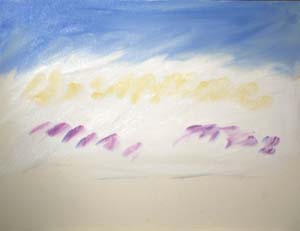|
|
SKY
Another question I have asked quite a few times is “I can never get my
skies thick enough without them looking muddy”. Well ask yourself does
your sky really need to by that thick? After all the sky is a lot of
vapour a long way away. Keep this fairly thin and build your thickness
up in the landscape progressively as you get nearer. Still associated
with skies is “I never seem to be able to get rid of the brush marks or
brush strokes in my sky”. Well lets answer both of the questions “cant
get my sky thick enough” and “cant get ride of my brush marks” in one
easy sky.
For this sky I am using a bit of Daler board which is a very inexpensive
surface and my No 18 Georgian wash brush. Firstly going in with some
titanium white to which I have added a little dip of my low odour
thinners and painting medium. Now some cobalt with a lot of
titanium white. Now in amongst that lot a little bit of naples yellow on
the top parts of the white, just a few daubs and then add a tiny touch
of permanent magenta to my cobalt blue and titanium white mix. And as I
said I have not made any of these too thick but my word what a mess
it looks.
|
So now lets
answer the other question of “how to get rid of my brush marks” as I am
turning it into a proper sky. Just with a gentle ragging together with
the colours at the top, then roll the white into the blue to form the
clouds, you’ve got rid of your brush marks and made that general mess
into a lovely soft sky.
Another question commonly asked is can I get the same effect by using
these techniques with acrylics the answer to that is quite simply yes,
but obviously you need to paint the acrylics in an oil fashion rather
than with loads of water and painting it in a watercolour style, but
remember however you treat it, your acrylics are going to dry that much
faster so work quickly.
|
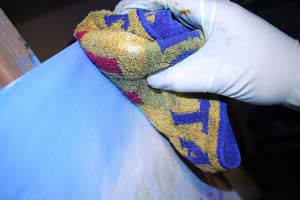
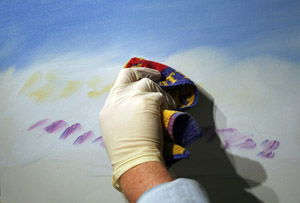 |
|
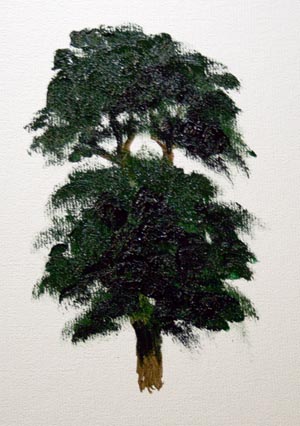
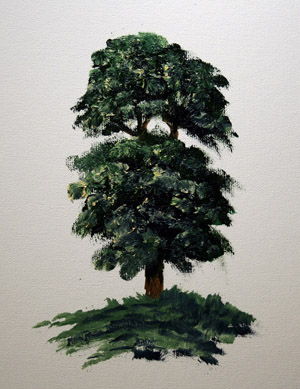 |
TREES
Another common problem is that of trees. Lots of people say “can I add
the light into my trees as I can in watercolours?” The simply answer to
this is yes if you wish, but the difference with oils is you don’t have
to do all that pre planning of where you want the light because with
oils you can paint your light on top afterwards.
In watercolours you would leave plenty of white paper showing here and
there. Which is a good way of getting light in. In oils, never leave
white canvas. It wont look natural and occasionally when the entire
painting is dried, any white canvas you have left will dry yellow.
Instead paint white on, or paint light on.
Take for instance this very simple little tree that I have done, for all
of that foliage I have used hookers green and burnt sienna. The I put a
mixture of cobalt blue and paynes grey to make some good dark strong
bits here and there.
Look at it now it looks dead and flat, until that
is with addition of a little bit of light in the form of naples yellow
it has a new life breathed into it with shape and depth.
|
|
One question I was asked
recently is can I do that double loading in watercolours like we just
did in oils, simple answer to that is no, or you could but you would
have to get your watercolours so thick that it would delude the
transparent quality of watercolour.
When I say double loading, this is
the kind of this I mean. Have a close look at my brush you will that I
have dark green mixture on one side of my brush and naples yellow on the
other side of my brush and with this, this is the effect I can get. By
simply tapping on with one side of my brush and then the other I can
have a very simple middle distance tree.
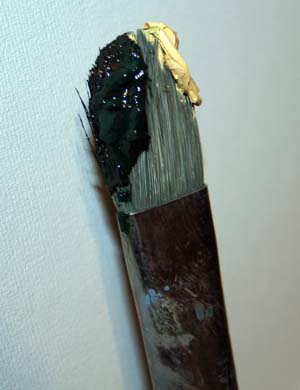 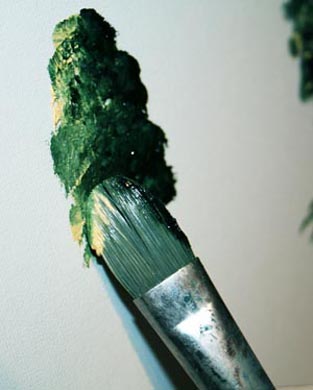 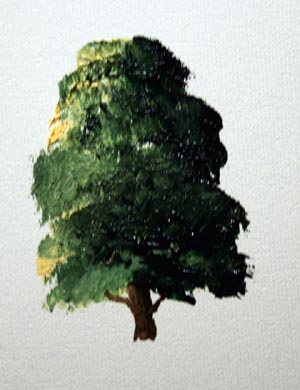 |
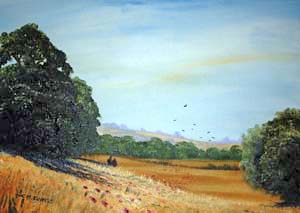 |
This is the first big tree that I did, just take a look of how effective the exact
same technique can be in a landscape painting, where you will notice the
big tree on the left hand side is done in exactly the same way.
Another statement rather
than question is “I always tend to get too fiddly with my landscapes,
how can I loosen them up” well for all these bits and pieces that I have
just done, I have used a number 18 wash brush a No 10 filbert and a
number 12 filbert, in other words no small brushes, this will stop you
getting tight and fiddly with unwanted detail. Because all of these
question, queries and answers are aimed at the landscape painter, a
landscape is a big free open, moving thing, don’t make it stiff and
lifeless using tiny little fiddly techniques and brushes.
|
Lets go back to the sky that we did and make that into a very simple
little picture using all of the bits I have just shown you.
With my no 10 filbert I have just scrubbed on hookers green and raw
sienna, followed by hookers green and burnt sienna for a darker tone,
and literally with the side of the brush just scrub it into the canvas,
and look at that you have go bushes from nothing.
|
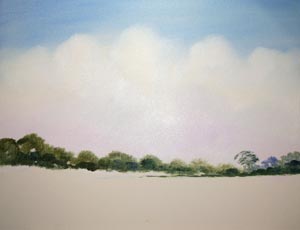 |
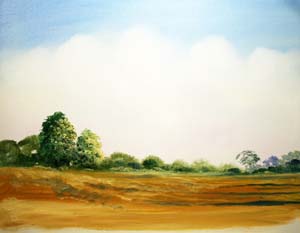 |
Now using the double loading
technique that I have just shown you tap on and get a tree on there. And
again with my No 12 filbert just slap on a little bit of raw sienna
followed by a bit of cobalt blue mixed with permanent magenta for a bit
of ground. Once the sky wash is done the rest took about 10 minutes and
one big brush. |
